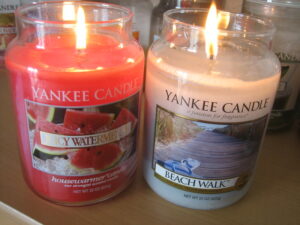Are Your Relaxing Candles Secretly Harming Your Health?

Dear GreenSmoothieGirl: I love using candles, but I’ve read they use toxic ingredients that burn into the air we breathe. What’s the truth?
Candles have been used for thousands of years – for their soothing effects.
Today, candles are popular, with approximately $2 billion in sales annually in the U.S.1
But, there’s a burning secret you need to know about candles if you, or the people you care about, ever use them:
Most candles are loaded with toxins with the potential to harm your health – and some candles can even be harmful to you when they aren’t even lit.
I’ve never sold candles and I don’t use them much, due to what you’ll read here.
But do you have to avoid candles altogether to reduce toxins in your life? Or, do safe candles exist?
Here’s what you’ll discover in this article:
- Why do you need to protect your health from toxic chemicals?
- A shocking truth about candle makers
- What ingredients in candles are concerning?
- What type of candle is most concerning?
- Do better candle options exist?
- Alternative to candles for your home
Why You Need to Protect Your Health from Toxic Chemicals
The truth is, we live in a “toxic soup” world – with over 80,000 chemicals2 registered for use in the U.S., in our air, water, and food.
When your body’s detoxification systems become overwhelmed, they can’t remove toxins from your body anymore.
Instead, the toxins are stored in your fat, muscles, bones, brain, liver, and other organs, which can seriously impact your health.
If you want your body to keep detoxing you as it should naturally, it’s important to know something about toxic chemicals in the products you use, and how you can take steps to protect yourself.
In truth, you can’t protect yourself 100% from toxins, but every step you take to reduce your toxic exposure makes a difference in your overall health, so you don’t overwhelm your detoxification systems.
If you like candles, what I’m going to share with you next might shock you.
Candle Makers Are NOT Required to List the Toxic Chemicals in Their Candles

Candle makers are NOT required to list or disclose toxic ingredients.
If you think you can read the labels to protect yourself from toxins in candles, think again.
Candles don’t have warning labels. And, very few regulations exist around the ingredients used in candles, so companies can put in pretty much whatever they want.
Furthermore, manufacturers are NOT required by law to list or disclose hazardous, toxic, or carcinogenic compounds used as ingredients in candles.
The only regulations on candles are related to fire safety, and not allowing metal-cored wicks unless they don’t exceed the maximum allowable lead limit.3
When it comes to candles, no one is protecting you. Even labels, such as “clean” or “all-natural,” might not mean what you think they do.
What Are the Main Concerns with Candles?
Candles are fast becoming one of the most common unrecognized causes of poor indoor air quality, according to the executive director of an American Lung Association project.4
Some researchers say candles are a “ubiquitous”5 source of indoor air pollution.
Candles potentially release many concerning chemicals, with impacts on cancer risk, inflammation in the lungs and throat, cognition, hormone disruption, cardiovascular disease, and other negative impacts on health.
The main dangers with candles are the emitted levels of these substances:
- VOCs (volatile organic compounds)
- PAHs (polycyclic aromatic hydrocarbons)
- PM (particulate matter, aka soot)
- Fragrance ingredients
Dangers of VOCs
VOCs are common in many products, such as furniture, cosmetics, and cleaning products.
[Related: Air Pollution Levels: What Are We Really Breathing?]
Many VOCs are generally considered harmless at low concentrations. However, some classes are concerning for inhalation, especially when concentrations build up indoors.
Exposure to VOCs can cause headaches, irritation to the eyes, nose, and throat, nausea, and damage to the liver, kidneys, or central nervous system.6
Some VOCs are suspected or proven carcinogens.
Burning several candles at once was found to exceed the U.S. EPA’s increased risk of cancer for three types of VOCs: acetaldehyde (a Class 1 human carcinogen7 that causes damage at the cellular and gene levels), formaldehyde (linked to cancers of the nose, throat, and sinuses8), and acrolein.
Some scented candles even act as powerful sources of VOC emissions whether they are lit or not!9
So simply having toxic candles in your home, and not even lighting them, could be a concern.
Dangers of POHs
Polycyclic aromatic hydrocarbons (POHs) are created from the burning of coal, oil, gas, wood, garbage, and tobacco.10
Wax burning from candles made of petroleum is a significant source of POHs.11
Many POHs found in candle fumes have been identified as carcinogens.11
In particular, chronic exposure to POHs has a connection with bladder cancer, as well as a substantial risk of lung, skin, and bladder cancer.12
Exposure to POHs also causes significant potential risk for throat and upper respiratory tract irritation.11
Dangers of Candle Soot
All candles produce soot. However, the amount differs depending on the type and quality of the wax.
Soot particles are very small, and are easily inhaled and deposited deep in the lungs.
Animal studies show that mice exposed to candle soot particles are associated with cytotoxicity and inflammation in the lungs13 – as well as telomere shortening, a marker for the risk of developing cardiovascular diseases.
Elevated soot levels have also been found to affect short-term cognition significantly.
Dangers of Fragrance Ingredients in Candles

Most scented candles are loaded with potentially harmful ingredients.
When you look at a candle, you may see the term “fragrance” or “parfum” – this is the fragrance loophole that allows fragrance ingredients to be listed under these generic terms.
In truth, petroleum is the source of 95% of the chemicals used in synthetic-scented candles.14
Frequent use of these scented candles in unventilated rooms may increase the chance of developing bladder cancer.15
The most common complaints from synthetically scented candles are vertigo, headaches, respiratory issues, watery eyes, stuffy nose, chest tightness, and a dry, irritated throat.14
Additionally, phthalates are used in candles to prolong the fragrance’s longevity. They are known endocrine disruptors, which can disrupt hormone balance, leading to conditions such as breast cancer, endometriosis, and reproductive harm.16
[Related: 14 Common Endocrine Disruptors That Can Disrupt Your Hormones]
The Major Ingredient in Most Toxic Candles
Most toxic candles are made from paraffin. And paraffin is derived from petroleum.
The black sludge from the bottom of oil barrels goes through a refinement process,17 where it is whitened using bleaching agents that are 10 times stronger than household bleach!
Toxic dioxins, known to be carcinogenic, are created through this refinement process. They can cause negative effects on reproductive, development, and immune systems.
Paraffin also releases carcinogenic chemicals when burned. The soot is similar to the soot released from a diesel engine – and can be as dangerous18 as second-hand cigarette smoke!
Gel candles may be the worst. They are made from a mix of petroleum and plastic.
Do Better Candle Options Exist?

Beeswax candles can be a safer, non-toxic candle option.
Terms like “all-natural,” “non-toxic,” or “safe for the family” mean nothing.
Everyone’s definition of safe is different, and none of those terms have regulations behind them. (In short, they mean whatever the marketer wants them to mean.)
“Plant-based” also means nothing, as some candle makers who use this term use paraffin wax in their candles.
All-natural candles made from beeswax, coconut wax, or soy wax (or a combination of these) are better options.
But, watch out for blends, because they can be deceiving! Most blends are just paraffin wax with a small amount of natural wax.
Beeswax candles with cotton wicks have a natural sweet honey fragrance. However, beeswax candles are often bleached or tinted with artificial colors. If you’re looking for a clean beeswax candle, look for a natural, deep-honey color.
Soy candles burn clean and don’t give off much soot19 – and they burn about 25% longer than paraffin. However, most soy candles are likely made with GMOs.
A Safe Non-Toxic Candle Option
Currently, MADE SAFE® is the only non-toxic certification organization that offers certification for candles.
This seal confirms that a household product is free from all toxins known or suspected to harm human health, animals, and ecosystems.
Certified goods have been thoroughly examined by researchers and scientists to ensure they’re made without known dangerous chemicals, like endocrine disruptors, VOCs, and carcinogens.
Fontana Candles are certified MADE SAFE®. They use beeswax, coconut oil, 100% pure essential oils, and certified wooden wicks.
GreenSmoothieGirl exclusive deal: you can save 15% off Fontana Candles. Use code GREENSMOOTHIEGIRL when you check out!
Tips for Burning Candles to Reduce Their Concerns
- Anytime you burn a regular candle, do it in an open space (i.e. not a small bathroom) with a cracked window to allow the fumes to be released
- Avoid burning multiple candles at once to reduce toxic exposures
- Avoid candles made with paraffin and gel candles
- Wax melts burn at slower temperatures and may be less toxic, though it’s still best to choose ones made with natural wax
- Use a candle snuffer to put out candles rather than blowing them out
- Choose candles made with natural materials, such as beeswax, coconut, or organic soy
- Choose candles scented with pure essential oils, rather than synthetic fragrances
- Choose candles made with 100% cotton, hemp, or wood wicks
- Be careful not to burn candles too long, because this increases the amount of soot
- Burn candles for special occasions and not regularly
- Add more indoor plants to help keep your home ventilated
Alternatives to Candles for Your Home
- Make or buy non-toxic potpourri and burn it on your stove
- Use a diffuser to enjoy the scent and benefits of 100% pure essential oils
- Use battery-powered candles for ambiance – they don’t burn but do give off a relaxing light
- Use Himalayan salt lamps for ambiance instead of candles
- Take a bath and add five to 10 drops of 100% pure essential oils
- Make or buy 100% pure essential oil sprays
Candles Are A Secret Source of Toxins and Air Pollution in Many Homes
Many of us love candles for the peace they bring us and how they improve the ambiance in our homes. But, candles have exploded in popularity – and the quality of most candles is extremely poor and loaded with toxins, especially candles made with paraffin (petroleum) and synthetic fragrances (also largely made from petroleum).
The serious risks to your health just aren’t worth it with regular candles. If you’re seeking some calm and a boost to your home ambiance, choose safer candles, burn them less often, and choose alternatives to candles.
Every step you take to reduce your toxic exposure matters for your health!
Read Next: Could Your Home Indoor Air Be Polluted? How To Clean It

Disclosure: This post may contain affiliate links that help support the GSG mission without costing you extra. I recommend only companies and products that I use myself.
References
- Ahn, Jeong-Hyeon et al. (2015). Characterization of hazardous and odorous volatiles emitted from scented candles before lighting and when lit. Journal of Hazardous Materials. https://doi.org/10.1016/j.jhazmat.2014.12.040
- Safer chemicals. Alliance of Nurses for Healthy Environments. https://envirn.org/safer-chemicals
- Shen, Y. (2022). Candle Safety Standards and Regulations in the US: An Overview. ComplianceGate.
- Downey, C. (2014). Toxins in Burning Candles, Candle Wicks, and Incense.
- Verdugo, I., Cruz, J.J., Álvarez, E. et al. (2020). Candle flame soot sizing by planar time-resolved laser-induced incandescence. Sci Rep. https://doi.org/10.1038/s41598-020-68256-z
- Volatile Organic Compounds' Impact on Indoor Air Quality. EPA.
- Rajendram, R., Rajendram, R., & Preedy, V. R. (2016). Acetaldehyde: A Reactive Metabolite. In Neuropathology of Drug Addictions and Substance Misuse. Academic Press. https://doi.org/10.1016/B978-0-12-800213-1.00051-1
Formaldehyde. Proposition 65. - Formaldehyde. Proposition 65.
- Ahn, J. H., Kim, K. H., Kim, Y. H., & Kim, B. W. (2015). Characterization of hazardous and odorous volatiles emitted from scented candles before lighting and when lit. Journal of Hazardous Materials. https://doi.org/10.1016/j.jhazmat.2014.12.040
- Polycyclic Aromatic Hydrocarbons (PAHs) Factsheet. CDC.
- Orrechio, S. Polycyclic aromatic hydrocarbons (PAHs) in indoor emission from decorative candles. Atmospheric Environment. https://doi.org/10.1016/j.atmosenv.2010.12.024
- Adamowicz, J., Juszczak, K., Poletajew, S., et al. (2019). Scented Candles as an Unrecognized Factor that Increases the Risk of Bladder Cancer; Is There Enough Evidence to Raise a Red Flag?. Cancer Prev Res (Phila). https://doi.org/10.1158/1940-6207.CAPR-19-0093
- Anderson, C. et al. (2021). Emissions of soot, PAHs, ultrafine particles, NOx, and other health relevant compounds from stressed burning of candles in indoor air. Indoor Air.
- Nazir, Z., Habib, A., Ali, T., Ghouri, H., & Haque, M. A. (2023). The unknown risks of scented candles! what science has to say: an editorial. Annals of medicine and surgery (2012), 86(1), 16–17. https://doi.org/10.1097/MS9.0000000000001524
- Adamowicz, J., Juszczak, K., Poletajew, S., Van Breda, S. V., Pokrywczynska, M., & Drewa, T. (2019). Scented Candles as an Unrecognized Factor that Increases the Risk of Bladder Cancer; Is There Enough Evidence to Raise a Red Flag?. Cancer Prevention Research.
- Hormone-Disrupting Chemical Detected in 90% of Europeans, Research Shows. Science Alert.
- Paraffin wax. Wikipedia.
- Scented candles can be as harmful as cigarettes, doctor says. Boston 25 News.
- Rezaei, K., Wang, T. & Johnson, L.A. (2002). Combustion characteristics of candles made from hydrogenated soybean oil. Journal of the American Oil Chemists’ Society. https://doi.org/10.1007/s11746-002-0562-y
Image Sources
- Toxic image used under a Creative Commons CC BY-SA 3.0 license by Nick Youngson
- Yankee Candle image used under a Creative Commons Attribution-ShareAlike 2.0 Generic license by Katy Warner on Flickr
- Beeswax candle image used under a Creative Commons license from Skylar Kang on Pexels
Posted in: Detox, Eco Friendly Living, Health Concerns, Lifestyle, Natural Products














